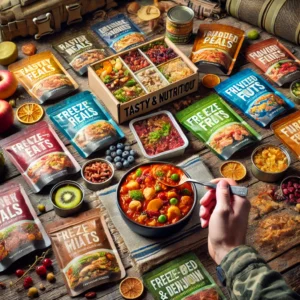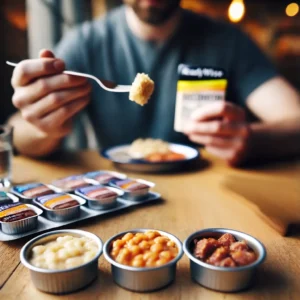
- September 23, 2024
- 11:43 pm
- No Comments
When disaster strikes, having a stash of survival foods can make all the difference. Whether it’s a natural disaster, unexpected power outage, or any other emergency, being prepared with the right food can help you and your family stay nourished and calm. But not all survival foods are created equal. It’s important to choose options that not only have a long shelf life but are also tasty and nutritious. Let’s dive into the world of survival foods and explore how to stock up wisely.
Stocking Up: What Are Survival Foods?
Survival foods are non-perishable items that can be stored for extended periods without spoiling. These foods are designed to provide essential nutrients and energy during emergencies when access to fresh food may be limited. Think of the times when grocery stores are closed, or you can’t step out of the house—this is when your stash of survival foods comes into play.
The first step in stocking up is understanding what counts as a survival food. Generally, these are canned goods, freeze-dried foods, dehydrated items, grains, and other long-lasting staples. The key is to choose items that can withstand time but also provide the necessary nutrition to keep you healthy and energized.
When building your survival food supply, it’s crucial to consider storage space. Opt for items that are compact and can be stacked easily. This is where canned goods and freeze-dried foods shine since they don’t take up much room and are easy to organize.
Another consideration is to diversify your stockpile. Having a variety of food types ensures you get a mix of nutrients and prevents meal fatigue. Imagine eating the same thing every day for weeks—not very appealing, right? Variety helps keep your meals interesting and nutritious.
It’s also wise to rotate your stockpile regularly. Check expiration dates and use items before they go bad, replacing them with new ones. This practice ensures that your stash is always fresh and ready to go when you need it most.
Lastly, don’t forget to include special dietary needs in your planning. Gluten-free, vegetarian, or allergies—make sure your survival food stash caters to everyone’s requirements so that no one is left out during an emergency.

Nutrient-Packed: Why Quality Matters
When choosing survival foods, it’s easy to focus solely on shelf life and forget about quality. But in times of crisis, your body will need all the nutrients it can get to stay strong and healthy. That’s why it’s crucial to opt for nutrient-packed foods that provide vitamins, minerals, and other essential nutrients.
First off, consider protein. It’s the building block of muscles and crucial for repair and recovery. Look for canned meats, beans, and even protein bars that are high in protein content to keep your body fueled.
Next up, don’t neglect the importance of healthy fats. Fatty acids are essential for brain function and energy. Canned fish like salmon and sardines are excellent sources of omega-3 fatty acids. Nuts and seeds are also compact options that pack a nutritional punch.
Vitamins and minerals are another consideration. Fruits and vegetables are the best sources, but fresh ones aren’t an option for long-term storage. Canned fruits and vegetables, as well as freeze-dried options, can provide necessary vitamins like A and C, along with minerals such as potassium and magnesium.
Hydration is another key component of survival. Dehydrated and freeze-dried foods are lightweight and space-saving, but they require water to rehydrate. Make sure you have a reliable supply of clean water to prepare these foods. Water purification tablets and portable filters can be a lifesaver.
Fiber is often overlooked but essential for digestive health. Whole grains, beans, and even some dehydrated fruits can ensure you get enough fiber to keep your digestive system running smoothly.
Lastly, consider incorporating superfoods like chia seeds, quinoa, and spirulina into your stash. These nutrient-dense foods can provide a significant boost of vitamins, minerals, and antioxidants, ensuring your body gets what it needs to stay healthy during stressful times.
Canned Goods: Versatile and Long-Lasting
Canned goods are a staple in survival food pantries for good reason. They are durable, have a long shelf life, and offer a wide variety of options. From vegetables to meats and even fruits, canned foods can be incredibly versatile.
One of the main benefits of canned goods is their longevity. Most cans have a shelf life of several years, making them ideal for long-term storage. This means you can stock up on a variety of items without worrying about them going bad any time soon.
Versatility is another major advantage. Canned beans, for example, can be used in soups, stews, or eaten on their own. Canned vegetables can be mixed into pasta dishes or served as a side. The possibilities are endless, allowing you to get creative with your meals even in a crisis.
Canned meats like chicken, tuna, and ham offer a quick and easy source of protein. They are fully cooked, meaning you can eat them straight out of the can if needed. This can be a lifesaver when you don’t have the means to cook a meal.
Fruits are often overlooked in emergency planning, but they shouldn’t be. Canned fruits can provide a sweet treat and are packed with vitamins. Look for options that are canned in their own juice or water to avoid unnecessary sugars.
One tip for using canned goods is to have a manual can opener on hand. In case of a power outage, an electric can opener won’t do you any good. A sturdy manual can opener ensures you can access your food whenever you need it.
Lastly, don’t forget to include soups and stews in your canned goods selection. These are often complete meals in a can and can be incredibly comforting and filling. Plus, many soups provide a good balance of protein, vegetables, and carbohydrates.
Freeze-Dried: Lightweight and Nutritious
Freeze-dried foods have become increasingly popular in the world of survival prepping. They are lightweight, have a long shelf life, and retain most of their nutritional value. This makes them an excellent choice for anyone looking to build a comprehensive emergency food supply.
One of the main advantages of freeze-dried foods is their weight. Because the water has been removed, they are incredibly lightweight, making them easy to store and transport. This is particularly useful if you need to evacuate and take your food supply with you.
Nutritional retention is another key benefit. The freeze-drying process locks in most of the nutrients, so you don’t lose out on essential vitamins and minerals. This is crucial for maintaining your health during an emergency when your body needs all the nutrients it can get.
Variety is another plus. From full meals like pasta dishes and stews to individual ingredients like fruits and vegetables, there’s a wide range of freeze-dried options available. This allows you to create diverse and interesting meals even in a crisis.
Preparation is usually simple. Most freeze-dried foods require just a bit of hot water and a few minutes to rehydrate. Some can even be eaten as-is, which is a bonus if you don’t have access to hot water.
Storage is a breeze with freeze-dried foods. They often come in sealed pouches or tins that can be easily stacked and stored. Just make sure to keep them in a cool, dry place to maximize their shelf life.
Lastly, freeze-dried foods are not just for humans. There are also freeze-dried pet foods available, ensuring that your furry friends are taken care of during an emergency as well. Pets are part of the family, and having a supply of food for them is just as important.
Grains and Pasta: Carbs for Sustained Energy
Carbohydrates are essential for providing the energy you need to get through tough times. Grains and pasta are excellent sources of carbs and have a long shelf life, making them perfect for your survival food stash.
Rice is a go-to for many preppers. It’s versatile, easy to cook, and can be used as a base for many meals. Opt for white rice for longer shelf life, but you can also include some brown rice for added nutrients.
Pasta is another excellent option. It comes in various shapes and sizes and can be paired with canned sauces, meats, and vegetables for a complete meal. Whole-grain pasta offers more fiber and nutrients than regular pasta, so consider including some in your stash.
Oats are incredibly nutritious and can be used for more than just breakfast. They can be a base for savory dishes or added to soups for extra bulk. Plus, they have a long shelf life and are easy to store.
Quinoa is a superfood that’s packed with protein, fiber, and essential amino acids. It’s easy to cook and can be used in a variety of dishes, from salads to stir-fries. Its shelf life is also impressive, making it a valuable addition to your emergency food supply.
Don’t forget about flour and baking mixes. Having these on hand allows you to make bread, pancakes, and other baked goods, even in an emergency. Opt for whole-grain flour for added nutrients and consider storing some yeast and baking powder as well.
Lastly, consider including some pre-packaged grain meals like instant noodles or rice packets. These are quick and easy to prepare and can be a comforting, familiar food during stressful times.
Snacks and Treats: Boosting Morale in Crisis
While it’s crucial to have nutrient-dense foods in your emergency stash, don’t underestimate the power of snacks and treats. They can provide a much-needed morale boost during stressful times and offer a sense of normalcy.
Granola bars and protein bars are excellent snack options. They are portable, have a long shelf life, and can provide a quick energy boost. Look for options that are high in protein and fiber to keep you fuller for longer.
Dried fruits are another great choice. They are sweet, nutritious, and have a long shelf life. Plus, they can be added to other dishes like oatmeal or yogurt for extra flavor and nutrients.
Chocolate may not be the first thing you think of when stocking up